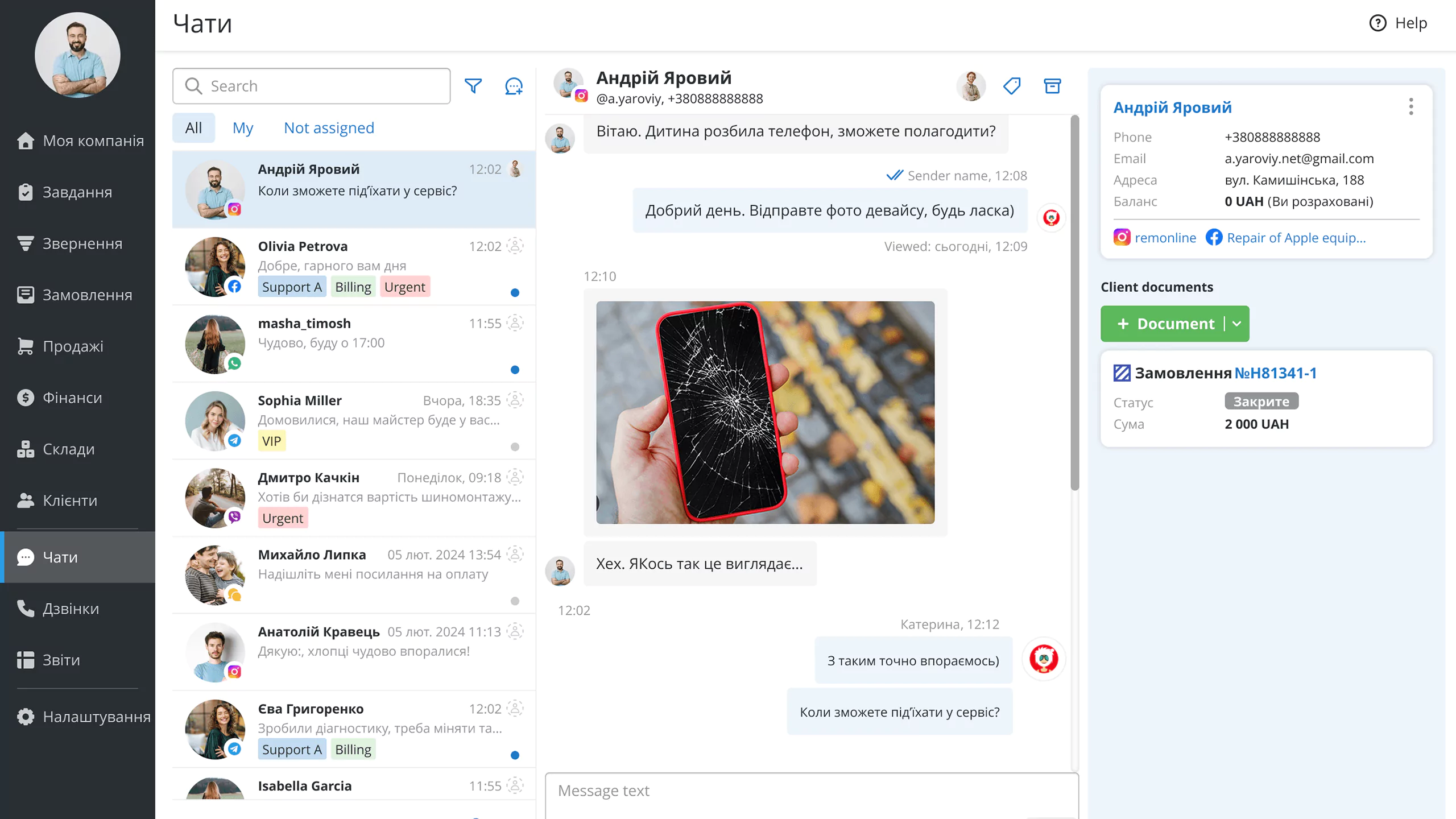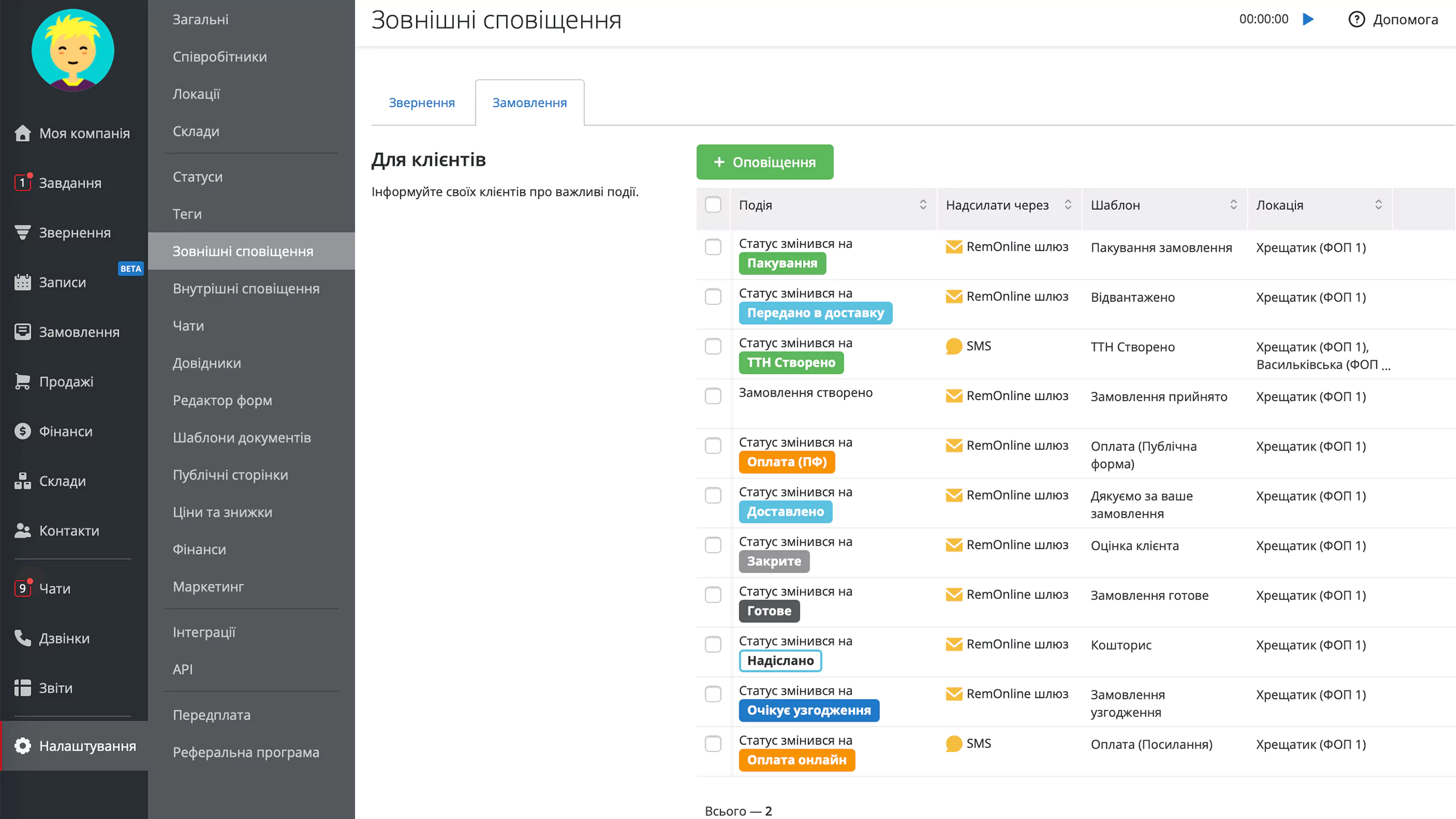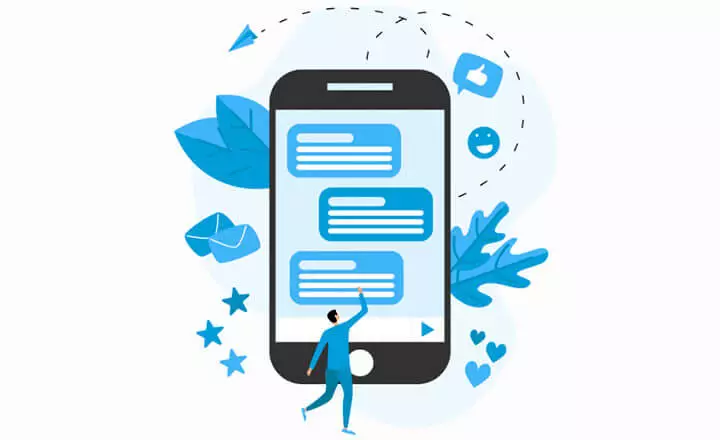Чати з клієнтами: як комунікувати бізнесу в 2025
Поради щодо комунікації, що приносить прибутки
Спілкування з клієнтом впливає на весь бізнес-процес — від першого контакту до повторних продажів. Налагоджена комунікація у вашому бізнесі допоможе залучити клієнтів, підвищити їхню лояльність та переконати їх привести своїх друзів. Читайте, як вибудувати спілкування так, щоб збільшити прибутки.
Чому комунікація важливіша, ніж будь-коли
Відносини з клієнтами не існують у вакуумі — вони формуються з часом за допомогою продуманих слів і дій. Якісне ділове спілкування допоможе сформувати позитивний емоційний звʼязок з покупцями, задовольняти їх сервісом та вирізнятись у конкурентному середовищі, яке посилюється з кожним днем. Ба більше, комунікація часто супроводжує важливі бізнес-процеси, такі як виставлення рахунків, формування кошторисів тощо.
Щоб правильно спілкуватися з клієнтами, тренуйтесь на співробітниках, контролюйте одне одного та шукайте спільні рішення. Коли ви навчитеся слухати, зосередитесь на емпатії та рішеннях, а не на звинуваченнях, результатом стане модель комунікації, що збільшує бізнес-показники без завʼязання на проблемах і конфліктах. Якщо команда вміє спілкуватися, вона зможе використовувати це вміння і в зовнішній комунікації.
Дізнайтесь більше про те, як ефективно спілкуватися з клієнтами
Ваші клієнти розраховують на швидкі та зрозумілі відповіді протягом усієї користувацької подорожі від першого контакту до закритої угоди. Якщо вони матимуть приємний досвід і довірятимуть вашому слову, це сприятиме їхній лояльності до бізнесу. А чим більше лояльності, тим більше рекомендацій, повторних замовлень і, відповідно, ваших прибутків.
Коли та про що спілкуватися з клієнтами
Коли маєте справу з десятками чи сотнями клієнтів, відповіді кожному вручну потребуватимуть немало часу і можуть спричинити справжній хаос. Щоб організувати комунікацію як чіткий послідовний процес і не губити повідомлення, використовуйте CRM для месенджерів RemOnline. Так ви зможете синхронізувати комунікацію з бізнес-процесами та переглядати історію спілкування, підключивши всі популярні месенджери та соцмережі.
Активуйте пробний період RemOnline, автоматизуйте комунікацію з клієнтами та відчуйте результат вже протягом 7 днів.
Найпростіший спосіб зрозуміти ваші комунікаційні потреби — просто спостерігати за робочими процесами у вашому бізнесі. На кожному кроці ви помічатимете точки взаємодії з клієнтом, що потребують удосконалення, і зрозумієте, де комунікацію можна стандартизувати, використавши ефективні фрази чи цілі скрипти.
 Синхронізація чатів та бізнес-процесів у RemOnline
Синхронізація чатів та бізнес-процесів у RemOnline
Коли ви вперше спілкуєтеся з клієнтом, він може поставити запитання, щоб зʼясувати, чи можете ви допомогти йому і як саме. Після етапу виявлення потреби клієнти чекають на швидкий прийом замовлення або реєстрацію. Тут важливим є дзвінок або повідомлення з підтвердженням.
Якщо маєте справу з наданням послуг або доставкою товарів, варто повідомляти клієнтів про зміни у статусі та очікуваний час готовності. А якщо надсилаєте рахунки або посилання на платіжні системи, потурбуйтесь, щоб покупець отримав підтвердження оплати. Також дієвою практикою є подальше спілкування з клієнтами, щоб вони оцінювали якість обслуговування. Збір відгуків допоможе покращити сервіс.
Сила SMS у бізнесі
SMS часто відкривають клієнти, формування повідомлення не потребує великої кількості часу та зусиль, а ще SMS є лаконічними, отже допомагають швидко передати потрібну інформацію та рухатись далі. Такі повідомлення ідеально підходять для термінових комунікаційних потреб, таких як оновлення, нагадування та підтвердження.
Читайте інструкцію, як обирати сервіси для SMS-розсилки
SMS-сповіщення також можна використовувати як доповнення до інших видів комунікації. Багато компаній дублюють в SMS зміст електронних листів чи повідомлення у месенджерах, щоб збільшити конверсію. Ба більше, за допомогою SMS ви можете нагадати про кошторис, який щойно був відправлений на Email, або опитування, до якого клієнт не перейшов через посилання, надіслане у Viber.
Щоб прискорити комунікацію з клієнтами, підключайте сервіси SMS розсилки до RemOnline. Інтеграція дозволяє надсилати автоматичні повідомлення (зміна статусу замовлення, нагадування про візит тощо), створювати шаблони, налаштувати відкладене та масове надсилання за контактами з бази клієнтів. Результат — економія часу, максимально швидкий звʼязок з клієнтами та покращення сервісу.
 Налаштування повідомлень за ланцюжком статусів у RemOnline
Налаштування повідомлень за ланцюжком статусів у RemOnline
При оформленні замовлення клієнт отримує SMS про терміни та вартість. Це економить купу часу, бо нам не треба телефонувати людині. Зазвичай ніхто не передзвонює, клієнти отримують інформацію, а ми беремо замовлення в роботу. Це позбавило нас непотрібної рутини.
Автоматизація для економії часу
Проаналізуйте, які месенджери, соцмережі та інші канали ви використовуєте і коли це робите. Так буде легше розуміти, що краще автоматизувати, а що можна робити вручну. Наприклад, якщо першою точкою контакту з вашим бізнесом є Telegram чат-бот, ви можете автоматизувати відповіді та інтегрувати бот з RemOnline. Це прискорить комунікацію та покращить сервіс, адже маючи всі чати в одному вікні, ви зможете відповідати швидше.
Якщо клієнту потрібно просто зараз отримати попередній розрахунок замовлення, ви можете створити його автоматично у RemOnline, лише додаючи товари/послуги, та надіслати комерційну пропозицію за кілька кліків. До речі, система підтримує онлайн-підтвердження кошторисів: надсилаєте розрахунок клієнту як веб-сторінку, а він підтверджує його натисканням кнопки або графічним підписом.
Працівники роблять попередній розрахунок та скидають клієнту. Якщо його все влаштовує, він приходить до магазину та сплачує на місці, або замовляє доставку і сплачує онлайн.

Микола Гнатій
Співзасновник
МаксБуд
Переваги автоматизації спілкування з клієнтами:
- Економія часу. Зусилля і час, витрачені на створення повідомлень з нуля та уточнення важливих деталей, краще спрямувати на процеси, що безпосередньо приносять прибутки. Створіть шаблони, щоб надсилати всі необхідні дані за лічені секунди в єдиному впізнаваному форматі.
- Послідовність. Використовуючи шаблони повідомлень, ви не забудете, що потрібно сказати клієнту і які дані необхідно отримати від нього. Послідовна та методична комунікація мінімізує помилки та нестачу інформації, а також формує відчуття стабільності у клієнта, лояльність якого життєво необхідна вам.
- Краще утримання. Автоматизуйте комунікацію, щоб спонукати клієнтів вчасно платити і не «зливати» етапи воронки продажів. Наприклад, ви як менеджер автосалону можете записати клієнта на послуги в Планувальнику RemOnline і запустити ланцюжок автоматичних повідомлень про запис. Результат — менше запізнень, скасованих візитів та втрачених грошей.
 Календар запису клієнтів у RemOnline
Календар запису клієнтів у RemOnline
Вибір оптимальних каналів комунікації
Щоб не втрачати повідомлення і контакти, а також не забувати вчасно відповідати клієнтам, варто зібрати канали комунікації в єдиній системі. Ось основні канали, які потрібні бізнесу в 2025 році та доступні в інтеграції з RemOnline:
- SMS. Один з найбільш надійних та ефективних каналів комунікації, що ідеально підходить для нагадувань про запис або оплату, оновлень статусу замовлення, опитувань та рекламних кампаній.
- Email. Чудовий варіант для надсилання кошторисів, рахунків та документів у PDF. Комунікація через електронну пошту допомагає надсилати більші обʼєми інформації та підтримувати впізнаваний корпоративний стиль у дизайні.
- Telegram, Viber i WhatsApp. Ці месенджери широко використовуються завдяки своїй поширеності та зручності в обміні даними. Також ці канали можуть стати відмінним інструментом для швидкої підтримки клієнтів.
- Facebook Messenger та Instagram Direct. Багато клієнтів звертаються через соцмережі, тому синхронізація чатів з них дозволяє швидко відповідати за допомогою шаблонів і без необхідності перемикатися між додатками.
В RemOnline ви можете контролювати ці канали завдяки єдиній картці клієнта — так ви будете відстежувати переписку з покупцями, що комунікують у різних месенджерах. Ба більше, це допоможе персоналізувати розмови, аналізувати настрій клієнта та відповіді співробітників, щоб покращувати сервіс та отримати більше продажів.
Порівняно з минулим роком наш бізнес зріс на 15-20%. І це не органічне зростання, бо ми не зросли у штаті або потужностях. Все завдяки правильній комунікації з клієнтами і RemOnline. Ми бачимо, як клієнти повертаються і замовляють знову.

Сергій Гєєв
Співвласник
Автофізика
Побудова міцних відносин з клієнтами
Ефективна комунікація допоможе вам залучати та утримувати більше клієнтів, щоб підтримувати стабільний потік продажів. Ось кілька порад, дотримуючись яких, ви встановите чудові відносини з клієнтами:
Будьте проактивними, а не реактивними
Беріть контроль у свої руки та ініціюйте розмови замість того, щоб чекати, поки це зробить клієнт. Навіть якщо клієнт звертається до вас першим, ви маєте ефективно комунікувати через маркетинг, веб-сайт, канали прямої комунікації та направляти людину до пошуку рішення.
Проактивна комунікація базується на 4 принципах: передбачення, підготовка, залучення і прозорість. Передбачення — це завчасне виявлення комунікаційних потреб, а підготовка передбачає створення ефективних рішень та інвестування в них. Залучення зосереджується на скороченні часу на відповіді та оновлення, тоді як прозорість відповідає за чесність вашої комунікації. А щоб швидше побудувати проактивну комунікацію, спробуйте ці способи:
- Забезпечте можливість живого чату на сайті чи інших платформах, адже далеко не всі клієнти люблять телефонні дзвінки.
- Узгоджуйте комунікацію з потребами бізнесу. Наприклад, якщо вам потрібен Email клієнта для надсилання кошторисів, зробіть збір електронної пошти обовʼязковим кроком у процесі запиту кошторису.
- Надсилайте сповіщення про технічні проблеми, такі як завантаженість служби підтримки, затримки з доставкою тощо. Негайно повідомте клієнтів, що працюєте над вирішенням і запропонуйте альтернативні опції.
Не забувайте спілкуватись після продажу
Просте запитання про якість обслуговування допоможе вам дізнатися, як більше задовольнити клієнта. Також це створює відчуття, що ви готові вдосконалюватись і відкриті до чесних відгуків. Комунікуйте через розумний проміжок часу, щоб дати час покупцю на випробування товару або послуги.
 Пропоновані ШІ відповіді у чатах RemOnline
Пропоновані ШІ відповіді у чатах RemOnline
Спілкуйтесь позитивно і доброзичливо
Пасивна агресія, грубість і відсутність емпатії проявляються у вашому виборі слів, емодзі та тону. Вам потрібен професійний, але доброзичливий тон комунікації, щоб залучати та утримувати клієнтів. Не забувайте, що спілкування має зосереджуватись на позитивних рішеннях і фактах, а не звинуваченнях.
Обирайте простіші слова замість складних, щоб не заплутувати клієнтів. Якщо вони не мають глибоких технічних знань, зосередьтеся на наданні елементарних пояснень. Якщо це можливо, організуйте процес затвердження повідомлень і створюйте шаблони, щоб зменшити шанс на «самодіяльність» вашої команди продажів.
Підсумок: Як комунікувати бізнесу в 2025 році
У сучасному бізнесі якісна комунікація з клієнтами — це ключ до лояльності, повторних продажів та більших прибутків. Завдяки конструктивній та позитивній взаємодії ваш бізнес зможе продуктивніше керувати процесами, покращувати сервіс та завойовувати довіру клієнтів.
Щоб автоматизувати комунікацію, використовуйте комплексні CRM для малого бізнесу та більших підприємств, такі як RemOnline. Система обʼєднує всі канали спілкування в одному вікні, допомагає поставити на потік рутинні повідомлення (статуси замовлень, кошториси, оплата), бути проактивними у комунікації та автоматизувати збір відгуків. Це заощадить час і збільшить прибутки, тому якщо ви не користувались RemOnline, активуйте безкоштовний пробний період і проведіть тест-драйв системи на вашому бізнесі.




